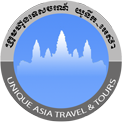Banteay Samray
|
In guidebooks, Banteay Samray is often called Bantay Samré, the latter being a combination of Khmer transcription and French spelling. Samray is the name of an ethnic group of people in the Phnom Kulen area. The first "a" in "Samray" sounds similar to an "o".
Banteay Samray was cleared by a French archaeological team of Maurice Glaize in 1930. After extensive restoration work between 1936 and 1944 according to the method called Anastylosis, this temple is one of the finest and most complete Khmer monuments now. Undoubtedly, Banteay Samray in its present condition is Angkor’s most significant flat temple from the Hindu period and the second most important example of the classical style of Angkor Wat, though not of such enormous size as Beng Melea outside Angkor or Phimai in North East Thailand. Like Angkor Wat, Banteay Samray was obviously dedicated to Vishnu, though no inscription was has yet been found to confirm this. It is a matter of debate whether Banteay Samray was built by Angkor Wat founder Suryavarman II or by one of his high-ranking court officials or by Suyavarman's less significant immidiate successor Yashovarman II. Like Angkor Wat, Banteay Samray is approached by a long, raised causeway, leading to a cruciform terrace. Probably it is of a later date, because the design of the cylindrical columns is of the Bayon style, though lion statues are very similar to those of the Angkor Wat. Unlike Angkor Wat, Banteay Samray is oriented to the east. But there is a second causeway at the back side in the west connecting the temple to the south-east corner of the former reservoir East Baray. Banteay Samray has two quite different and contrasting enclosures. The outer (83m x 77m) is a laterite gallery in a warm reddish tone, the inner court and its edifices are completely built in sandstone, which is of a grey colour. Both enclosures' gate pavilions, at the cardinal points, are decorated with excellent reliefs, at pediments in particular. These sandstone carvings are strikingly deep. The outer enclosure was framed by a colonnade, the tiled roofs are vanished. In places, it is a real symphony of columned windows. An interior moat with laterite paving, filled with water after heavy rainfall till the present day, is a unique feature inside a Khmer temple complex. The sandstone buildings inside the central enclosure are framed by narrow platforms. The buildings bear reliefs at pediments and lintels and at the bases of the pilasters. Their ornamentation is of exceptional quality. Some reliefs on the upper levels of this Hindu sanctuary show Buddhist scenes. Surprisingly, this temple in the style of Angkor Wat has no Apsara depictions. There is a stone coffin in the main sanctuary. Originally there was a Vishnu statue inside the central Prasat tower. Unfortunately, many sculptures and some carvings of Banteay Samray were stolen between 1945 and 1947 and during the Cambodian civil war from 1980 to 1995. The best time to visit Banteay Samray is the late morning. The buildings inside the inner encloser stand close together, this is why in the early morning only the roofs are in the sunlight. Furthermore, the late morning hours offer better shades for most of the carvings. In order to see each and every carving in the best sunlight, you would have to stay the whole day or come several times. Bantay Samray it is the only major Angkor temple situated neither along the Grand Circuit nor the Small Circuit. The temple is located about 300 m east of the former East Baray, and 4 km east of the Grand Circuit road. You have to leave the Grand Circuit 200 metres south of the East Mebon and take the straight road to the east in order to reach Banteay Samray. An Angkor ticket is mandatory for visitors of Banteay Samray. |
